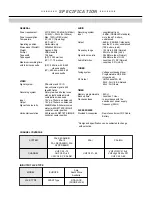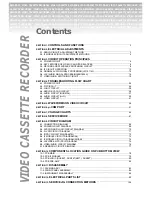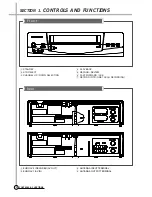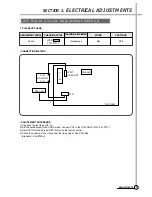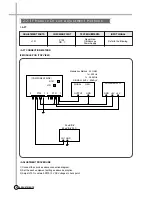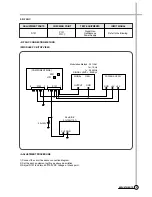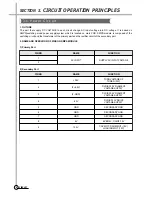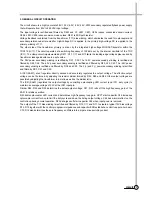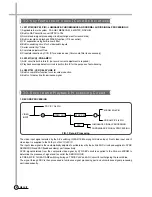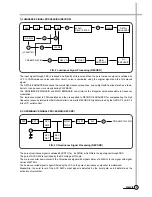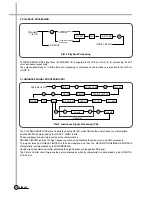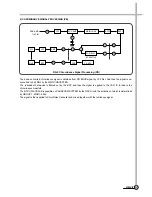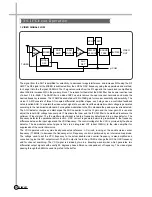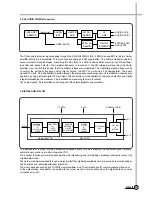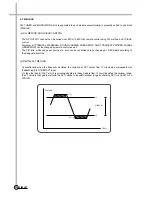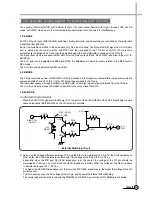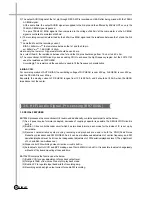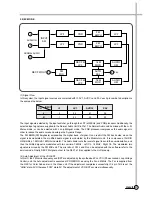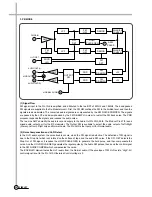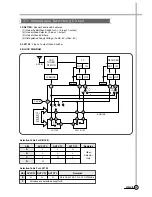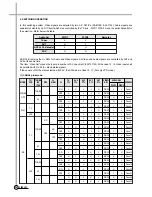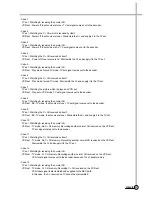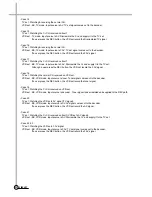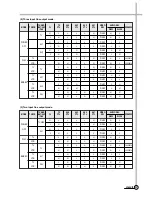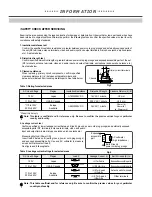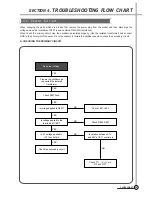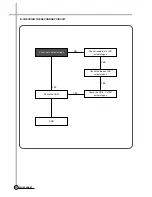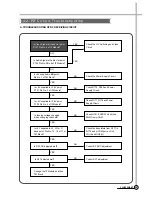
12
1. VIDEO SIGNAL FLOW
The signal from the ANT is amplified for selectivity, to decrease image interference, and increase S/N using the RF
AMP. The RF signal at the MIXER is subtracted from the LOCAL OSC frequency using the upperside band method,
to change it into the IF signal; 38.9MHz. The IF signal converted from the RF signal in the tuner block is amplified by
about 20dB to increase S/N in the pre-amp block. The reason for thesis that the SAW filter has its own insertion loss
of about -18 to -22dB. The SAW filter is a kind of BPF, used to remove the near channel harmonics and make the
desired frequency response. The IF AMP desired of about 60 to 70dB gain for receiver sensitivity and selectivity. The
vision IF AMP consists of three AC-coupled differential amplifier stages; each stage uses a controlled feedback
network called AGC. To maintain the video output signal at a constant level the automatic control voltage is generated
according to the transmission standard. For negative modulation in the PAL standard the peak-sync level is detected.
The AGC detector charges and discharges the AGC capacitor to set the IF gain and the tuner gain. We can also
adjust the tuner AGC voltage take over point. This allows the tuner and the IF SAW filter to be matched to achieve the
optimum IF input signal. The IF amplifier output signal is fed to a frequency detector and to a phase detector. The
frequency detector is operational before lock-in. A DC current is generated which is proportional to the frequency
difference between the input signal and the VCO frequency. The control voltage for the VCO is provided by the phase
detector. The demodulate output signal is fed via an integrated LPF (about 12MHz) to the video amplifier for
suppression of the carrier harmonics.
The VCO operates with a symmetrically-connected reference L-C circuit, running at the double vision carrier
frequency (77.8MHz) to decrease the frequency error. Frequency control is performed by an internal varicap diode.
The voltage used to set the VCO frequency to the actual double vision carrier frequency, is also amplified and
converted to give the AFC output current. The AFC output is fed to the µ-COM to change the LOCAL OSC frequency
and for channel searching. The VCO signal is divided by-two in a travelling wave divider, which generates two
differential output signals with exactly 90 degrees phase difference, independent of frequency. The video signal
passing through the 5.5MHz sound trap is fed to the buffer.
3-4. IF Circuit Operation
PRE-
AMP
MIXER
LOCAL
OSC
TUNER
SAW
FILTER
VIDEO DET
& DE MOD
VCO
AFC
SOUND
TRAP
BUFFER
RF
AMP
IF
AMP
VIDEO
OUT
µ
-COM
AGC
DET
CIRCUIT
Summary of Contents for DV-K88 series
Page 71: ...68 CIRCUIT DIAGRAMS 9 1 Connection Diagram SECTION 9 CIRCUIT DIAGRAM 68...
Page 72: ...69 CIRCUIT DIAGRAMS R819 5 1 9 2 Power Circuit Diagram...
Page 73: ...70 CIRCUIT DIAGRAMS 9 3 Syscon and Logic Circuit Diagram...
Page 74: ...71 CIRCUIT DIAGRAMS 9 4 AV SW Circuit Diagram...
Page 75: ...72 CIRCUIT DIAGRAMS 9 5 IF PDC Circuit Diagram TM...
Page 76: ...73 CIRCUIT DIAGRAMS 9 6 If Module Circuit Diagram A2...
Page 77: ...74 CIRCUIT DIAGRAMS 9 7 If Module Circuit Diagram Nicam...
Page 78: ...75 CIRCUIT DIAGRAMS 9 8 Hi Fi Pre Amp Circuit Diagram...
Page 79: ...76 CIRCUIT DIAGRAMS 9 9 Video Audio Circuit Diagram...
Page 80: ...77 CIRCUIT DIAGRAMS 9 10 Remocon Circuit Diagram...
Page 81: ...SECTION 10 COMPONENTS LOCATION GUIDE ON PCB BOTTOM VIEW 78 P C B LOCATION 10 1 PCB Main...
Page 82: ...80 P C B LOCATION 10 3 PCB Logic DV K8K S S Series DV K86 S S Series DV K82 S S Series...
Page 83: ...81 P C B LOCATION DV K88 S S Series...
Page 84: ...SECTION 11 DISASSEMBLY 83 DISASSEMBLY 11 1 Packing Ass y...
Page 85: ...84 DIAGRAMS DV K88 Series DV K82 Series DV K8K Series DV K86 Series 11 2 Front Panel Assembly...


